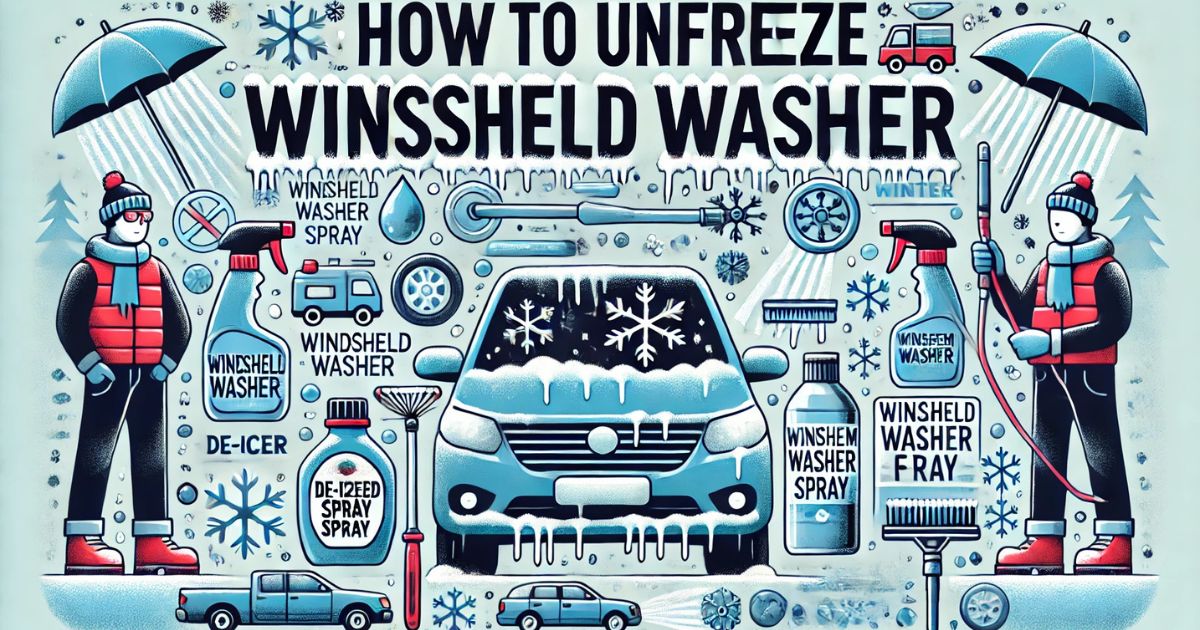Introduction
During the colder months, one of the most common winter car issues is a frozen windshield washer system. When your washer fluid freezes, it can leave you unable to clean your windshield, affecting visibility and safety. Understanding how to unfreeze windshield washer components—like the reservoir, lines, and nozzles—can get your system back in working order quickly and prevent long-term damage. This guide provides step-by-step solutions, prevention tips, and product recommendations for dealing with frozen washer systems.
Why Does the Windshield Washer Freeze?
Most standard washer fluids are made with a mix of water and alcohol. If the fluid isn’t rated for low enough temperatures—or if too much water was added—it can freeze in the reservoir, hoses, or spray nozzles when the temperature drops below freezing.
Common Areas That Freeze:
- Washer fluid reservoir
- Washer fluid lines (tubing)
- Spray nozzles
- Washer pump (in severe cases)
Signs Your Windshield Washer Is Frozen
- No fluid sprays when you activate the washer
- Low humming sound but no spray
- Fluid leaks once it thaws
- Visible frost or ice in reservoir or lines
- Warning light for low washer fluid (even if full)
How to Unfreeze Windshield Washer System
Step 1: Move Vehicle to a Warmer Environment
- If possible, park your car in a garage or heated area.
- A few hours in warmer temperatures may thaw the fluid naturally.
Step 2: Use a Hair Dryer or Heat Gun (Safely)
- Open the hood and aim warm air at the washer reservoir.
- Avoid direct heat or open flames to prevent melting plastic or causing a fire hazard.
- Run the dryer for 10–20 minutes at intervals, checking progress.
Step 3: Add Washer Fluid with a Lower Freezing Point
- Use a de-icing washer fluid rated for subzero temperatures.
- Pour into the reservoir to mix with existing fluid and help lower its freezing point.
- Avoid overfilling—leave room for expansion.
Step 4: Start the Engine and Run the Defroster
- Heat from the engine and windshield defroster can help warm the washer lines and nozzles.
- Activate the washer intermittently once you suspect thawing has begun.
Step 5: Clear Nozzles and Lines
- If the nozzles remain clogged, use a pin to gently remove any ice buildup.
- Warm water (not boiling) can be poured over the hood area to thaw nozzles.
- Replace cracked or damaged hoses once thawed.
How to Prevent Windshield Washer from Freezing
Use Proper Washer Fluid
- Choose winter-grade washer fluid rated for at least –20°F or lower.
- Avoid mixing with water unless absolutely necessary.
Empty and Replace Summer Fluid
- Drain or flush any leftover summer washer fluid before cold weather arrives.
- Refill with cold-weather fluid at the start of winter.
Park Smart
- Use a garage or carport when possible.
- Park facing the sun to maximize natural heat.
Run the Washer System Weekly
- Use the washer system periodically in winter to keep fluid circulating.
Troubleshooting After Thawing
Fluid Still Doesn’t Spray?
- Check for leaks in hoses or connections.
- Inspect the washer pump fuse.
- Test the pump motor—it may be damaged from trying to operate while frozen.
Refill Reservoir if Empty
- Ice expansion can crack the reservoir and drain fluid once thawed.
- Refill with winter-grade fluid and check for leaks.
FAQs
Can I use hot water to unfreeze the washer system?
Warm water is okay, but avoid boiling water, as it can crack plastic parts.
Will a frozen washer system damage my car?
If left frozen for too long, it can damage the pump, lines, or reservoir.
Is there a washer fluid that won’t freeze?
Yes, winter or de-icing washer fluids are available and typically rated down to –20°F or –40°F.
Should I add rubbing alcohol to the fluid?
In an emergency, you can mix a small amount of isopropyl alcohol, but use caution—it can damage paint and rubber if overused.
Conclusion
Knowing how to unfreeze windshield washer fluid and components can save you frustration and help maintain safe visibility in winter conditions. From simple warming methods to using the right washer fluid, these tips will help get your system flowing again. Always prepare before the first freeze by switching to winter-rated fluid and maintaining your system to avoid costly repairs or safety risks.
